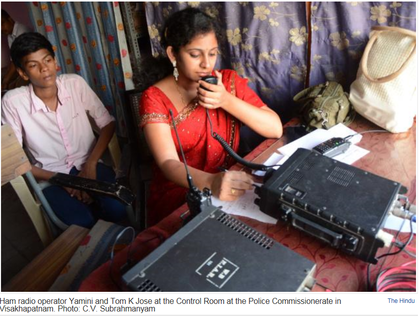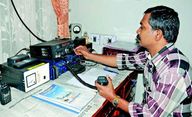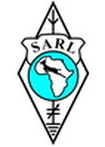Amateur Radio News From Around The World
South AfricaPEARS VHF/UHF ContestThe first session of the Port Elizabeth Amateur Radio Society (PEARS) VHF/UHF Contest will start at 18:00 on Friday 16 January and ends at 16:00 on Saturday afternoon.
The second session commences immediatly therafter and the contest concludes at 14:00 CAT on Sunday 18 January 2015. Country-wide contacts are possible throughout the day via Tropo propagation, but Tropo Ducting will peak an hour or two after sunrise on 50 MHz, 144 MHz, 432 MHZ and 1296 MHz. The preferred band at night is 144 MHz, the Tropo band, which could produce some very long distance contacts during Tropo Ducting. Keep an eye open on 50 MHz, the Magic Band, around noon to 14:00 for possible strong Sporadic-E DX openings from Namibia and Zimbabwe, where amateurs have been alerted about Es conditions. All times are in South African Standard time. Divisional prizes for the winners in the 144,400 MHz FM category have so far been confirmed by several divisions, and will be presented to the respective winners by the sponsors. Division 1 - pending. Division 2 - Rory Morton, ZS2BL, a dual 2m/70cm Yagi beam antenna, Division 4 - pending, Division 5 - Highway Amateur Radio Club, a dual 2m/70cm Yagi beam antenna, Division 6 - Willem Badenhorst, ZS6WAB, a dual 2m/70cm Yagi beam antenna. The winner and runner-up in this category will be rewarded with a certificate. Certificates will be e-mailed by ZS2FM on behalf of PEARS. South AfricaHAMNET In Three Separate RescuesOver the weekend of 28 December, HAMNET Western Cape was involved in three rescue missions.
Paul van Spronsen, ZS1V, Hamnet National Director, was on Western Cape Search and Rescue Logistics Duty Management and it was his responsibility to deploy the appropriate available resources to three incidents. At 21:32 on Sunday 28 December, ZS1VCC and ZS1ZW were called out to respond to Rocket Road above Sandy Bay and to accompany a metro team to provide communications support to rescue three students. The students were extracted to safety early the next morning. Earlier that evening at 20:30 Pierre Tromp, ZS1HF, and David, ZU1D, teamed up with Johan, ZS1JVW, who was already in place near the du Toits Kloof tunnel and who had communications with SkyMed. A paramedic and a mountaineer had earlier the afternoon been dropped into the kloof. The medic treated the patient and packaged her in preparation for a chopper extraction. The chopper extracted the patient and flew back via Groote Schuur Hospital at 22:55. The third incident was a party of 5 lost in Suicide Gorge - a kloofing trail in the Nuweberg nature reserve near Grabouw. No Hamnet members were despatched to that incident. The team there consisted mostly of members of the K9SAR team. It just shows again the communication support that radio amateurs are able to provide the community when most needed, yet it often goes unnoticed. South African Radio League Home Page South African Radio League Home Page # YOUTHNET - Join the SARL Youthnet today Sunday 4 January 2015 at 15:00 on 7070 kHz #SARLNEWS/NUUS 4 January 2014 English Afrikaans View on www.sarl.org.za Preview by Yahoo United KingdomFirst 2015 meeting of London Hackspace Amateur Radio ClubSaturday, 10 January 2015, 2PM onwards
For the curious: What's amateur radio? Read our brief what-and-why on the hackspace wiki here: http://hack.rs/w/Amateur_Radio/WhatWhy For the interested: We'll have a casual 'greasy brunch meetup' at Billy's at 1PM beforehand if you want to ask any beginner questions. We did very well for a club that's only a year old - we're keeping the heat going in the cold season: December Highlights * Hacked on mast and separated sections for further repair * Several international long-distance QRP (low-power) digimode contacts made by members both at the LHS radio shack and at home - (Example: Using only 10 watts of power to chat to Japan (9000+ miles away)? Wow, nice job, Jan!) * Donations of RF Spectrum Analyser and other nice bits for the shack * Co-authored submission for RSGB National Club of the Year 2014 January meeting agenda * Final review of SurveyMonkey results (quick hint: we all want antenna infrastructure!) * Hack on mast if we can manage the weather (bend back bent poles, etc.) * Club Antenna build-out proposals and review by G6VZM - leveraging JJ’s 'Elmer wisdom' * Rough plan for 2014 Foundation & Intermediate Training Course Dates * Submit ‘official’ 2014 club meeting dates to RSGB Our meeting will be held at 447 Hackney Road, London E2 9DY and will include tours of the shack and space for non-members (time allowing). We look forward to seeing you there and having a fun time. M0HSL (Our club callsign) Met department to showcase Ham radio for Bengal FishermenBy Indo Asian News Service | IANS – Mon, Dec 8, 2014
Kolkata, Dec 8 (IANS) Benefits of amateur radio (Ham radio) will be showcased for West Bengal's fishermen community in a bid to ensure severe weather warnings reach them timely when they are stationed in deep seas, an official said Monday. Experts at the regional meteorological department will facilitate a demonstration of the technology to the fishermen at one-day meet in Digha Dec 12, with the help of Bengal fisheries department and West Bengal Radio Club (Amateur Club). "We are trying to introduce the benefits of Ham radio to the fishermen and the state government officials as an alternative way of communication," Devendra Pradhan, deputy director general of meteorology (eastern region), regional meteorological centre, Kolkata, told IANS. "If the state government decides to go ahead with it, then Ham could be used to effectively transmit warnings to the fishermen, sailing in the deep sea, about 200 km away from the sea shore," he said. Ambarish Nag Biswas, a licenced amateur radio operator and founder of the club, and two of his colleagues, will explain the technicalities to the participants to apprise them of how the high frequency (HF) radio waves can be successfully used for direct, long-distance communications in inclement weather. "We will show them how to use the Ham radio to communicate with the authorities as well as with each other during severe weather conditions and explain the process of procuring licenses," Biswas, whose club is headquartered at Sodepur High School on the outskirts of Kolkata, told IANS. He was part of the three-member team that helped in communication during the cyclone Hudhud relief operations in Andhra Pradesh. Biswas said currently the fishermen use very high frequency (VHF) radio waves (ideal for short-distance terrestrial communication) for such transmissions. "Our agenda will be to persuade the state government officials to switch from the current VHF to HF," he said. Ham Geeks in Operation
When all communication networks are down, Ham plays a significant role in disseminating information. On the orders of the DGP, a 10-member team of National Institute of Amateur Radio (NIAR), led by its founder and chief advisor S. Suri, arrived here on Wednesday.A man from Naglonda is desperate to find out the safety of his brother staying at Vijayanagar Palace layout in the Hudhud-battered Visakhapatnam.
A colonel is living at PM Palem and his son in Kerala is frenetic to know how he is. At Padmanabham near Bhimili that suffered badly in the cyclone there is no power or water. These are pieces of information tricking in from a few Ham (amateur) radio operators that are working in the cyclone-affected areas of Visakhapatnam and received at the Control Room set up at the Police Commissioner’s Office. Ham has significant role to play when communication networks are down. On the orders of the DGP, a 10-member team of National Institute of Amateur Radio (NIAR), led by its founder and chief advisor S. Suri, arrived here on Wednesday. “We came here in five teams with five high frequency sets and six very high frequency and ultra high frequency sets. On contacting DCP M. Srinivas and SP (Communications) Surya Rao, we have been told to go to four places to improve police communications as the load on their devices is heavy,” says Yamini, a celebrity Ham operator and an entrepreneur who took keen interest in amateur radio right from her junior college days. Over the last few years she emerged a leader participating in international conferences. She has to her credit the distinction of representing Asia in a 12-member team from all over the world in an experimental Ham operation on Isla del Coco, an uninhabited island in Costa Rica, braving risks and obstacles. She has been participating in Ham operations in all the cyclones and floods since 2006, she says. She has not studied communication engineering but pursued it with intense interest even using earth-moon-earth communication process. Easy to operateThat Ham radio is easy to operate by even students is illustrated by Tom K Jose from Hyderabad, now in junior intermediate. With his father working in NIAR, he took quite early to the operation and Hudhud is his first operational exposure. COMES IN HANDY Ten members from National Institute of Amateur Radio arrive They are equipped with high-frequency sets #Celebrity operator Yamini, who has been participating in Ham operations in all cyclones and floods since 2006, is part of the team #Task assigned To improve police communication IOTA News from the Deutscher Amateur Radio Club 7 January, 2014 Island activities: AF-032; 5H; Zanzibar Island: Vittorio/I2GPT will be active as 5H1VC from Zanzibar (WLOTA 80, WFF 5HFF-003) from the 4th to the 12th of January. QRV mainly in CW on 40-10m, but also in RTTY on 20m. QSL via RW6HS (see qrz.com). http://www.i2gpt.com AS-013; 8Q; Maldive Islands: Mike/OE1SSS announces a holiday-style activity as 8Q7SM from the 4th to the 11th. QRV on 40, 30, 20, and 10m. QSL via OE1SSS (d/B). EU-125; OZ; Jylland West group: Following his activity from Romo Island (DIA NS-001) until New Year's Ric/DL2VFR will be active as OZ/DL2VFR until January 3. QRV on HF in CW. QSL via DL2VFR (d/B). http://www.iota-expedition.com/ NA-001; C6; Great Bahama Bank group: John/9H5G plans an activation of Stocking Island from January 1 to 31 as 9H5G/C6A. QRV from 160-10m in SSB, PSK, RTTY, JT65, and JT9. He also plans several trips to the Caribbean in 2014, see qrz.com. QSL via LotW, eQSL or direct via NI5DX. NA-096; HH/HI; Hispaniola: Andrey/RU4LG, Dmitry/RA4LB, Serge/UA4LGS and Pavel/UA4LL, will be active as HI8/homecalls until January 7. QRV with 100W on HF in CW, SSB, and digital modes. QSLs via h/cs. NA-174; VY0; Nunavut (Foxin Base) group: David/VE3VID returns to Igloolik Island (WW Loc. EP99) and hopes to get on the air from January 1 onwards as VY0/VE3VID on 20m. He plans to participate in the ARRL RTTY Roundup. QSL via VE3VID (d/B). OC-009; T8; Palau Islands: Ryosei/JH0IXE is currently active as T8CW from Palau. He continues to operate on 160-6m in CW, SSB, RTTY, SSTV, and PSK until the 6th of January. QSL via LoTW, eQSL, JA0FOX (B) or JH0IXE (d). OC-042; DU1/2/3/4, Luzon Island: Mike, W6QT, will be on the air as DU3/W6QT from Luzon until March. He has been heard on 40, 20, 15, and 10m so far, but wants to focus on the low bands. QSL via h/c (d/B), LoTW, eQSL. SA-025; PS8, Piaui State group: Raimundo/ PT7CG and Renner/PY7RP have rescheduled their operation as ZX8DX from Pedra do Sal Beach on Grande de Santa Isabel Island. It will now take place during the first two weeks of January. QSL via PT7CG. UK Emergency Group Marks it's 60th Anniversary
In addition to the lives lost, The East Coast Flood of 1953 caused 1.2 billion British Pounds in damaged, covered more than 160,000 acres and forced more than 32,000 people to evacuate. A huge storm surge had preceded the 1953 flood, overwhelmed the low lying areas of the Thames Estuary and the East Anglia region. Evacuations of these areas were hindered by the lack of effective communications. Ham radio operators, as they often do, filled that gap. was started. Today the 2,000 licensed amateur radio operators of RAYNET serve as the UK's premier volunteer communications group. In an effort to advance emergency communications, as well as amateur radio, RAYNET and the Radio Society of Great Britain (RSGB) have entered into a formal agreement to work together. RAYNET Chairman Cathy Clark G1GQJ was quoted by the Yorkshire Post as saying: “The East Coast Flood of 1953 was a terrible disaster but it precipitated the creation of a group of communications volunteers which, despite advances in technology, is needed now more than ever. “With our current unpredictable climate and the high risk of failure of modern communications networks RAYNET volunteers can make a crucial difference.” Like their counterparts around the world RAYNET not only provides vital communications for emergency responders when existing communications networks fail or become overloaded, but also assist with public service events such as parades, marathons, and festivals. |
United Kingdom Clive Ward G1EUC Clive Ward G1EUC
Essex Morse Code Classes
Chelmsford Amateur Radio Society invite you to join their Morse classes which will be starting at 7pm on Thursday, January 15 at the Danbury Village Hall CM3 4NQ Newcomers will be made very welcome. Start either as a complete beginner or the Morse team can help you to build up your confidence on the Morse and paddle key. Contact Andrew, G0IBN, on 01621 868347 or email: g0ibn<at>kersey1.freeserve.co.uk Also starting January 15 is the Foundation training course. To find out more speak to Clive G1EUC on Tel: 01245-224577 Mob: 07860-418835 E-mail: training2015 at g0mwt.org.uk Web: Chelmsford Amateur Radio Society - Foundation, Intermediate & Advanced Exam Training Courses BorneoBorneo Post: Youths asked to pick up amateur radioby Lim How Pim, [email protected]. Posted on December 12, 2014, Friday
SERIAN: Youths have been asked to pick up amateur radio not just as a hobby but a skill to ultimately lend a helping hand to the authorities in times of emergencies. John David Nyaoh, a political secretary to the Chief Minister, said this when opening a workshop by the Sarawak Amateur Radio Emergency Services (Sares) yesterday. “I urge young people to be involved in amateur radio, make it a hobby so that eventually you are able to assist your countrymen and villagers during emergencies. “By so doing, you will help save lives and properties,” he said when representing Minister of Infrastructure Development and Communication Dato Sri Michael Manyin Jawong at the workshop attended by 150 individuals. John recalled a time when the only means of communication was radio particularly in rural areas. “There was no other form of communication, no TV and not even newspapers. The information we got was very little and we had no news about what was happening on the other side of the world. “Only those in urban areas had access to newspapers to learn about what was happening. Communication at that time was unlike what we have today. Back then, the only form of communication with the outside world was through telegraph, which took time compared with the modern facilities we have today.” He pointed out that without an effective means of communication, lives were lost when natural disasters like floods and landslides happened. Amateur radio, also known as ham radio, he said, could operate on its own without the need for power supply. “When all power and services fail, amateur radio is there to assist particularly during disasters.” He announced on behalf of Manyin a government grant of RM5,000 for Sares, a non-governmental and non-profit organisation formed in October last year. Meanwhile, Sares vice-president Joseph Siong said a couple of helicopter tragedies in remote areas and boats sinking in Belaga and Kapit prompted a team comprising various professionals to set up the emergency radio unit to provide first responders with communication support. “We are volunteers, and we have limited manpower. We intend to recruit more people, especially young ones, to join us in order to assist the Civil Defence Department (JPAM) during emergencies. “We are now a partner of JPAM, assisting them in their communication and technical matters. JPAM has requested us to install the communication equipment for them, which currently covers areas such as Lundu, Bau and Serian,” he said. Read more: http://www.theborneopost.com/2014/12/12/youths-asked-to-pick-up-amateur-radio/#ixzz3NDoGxvXg
|




